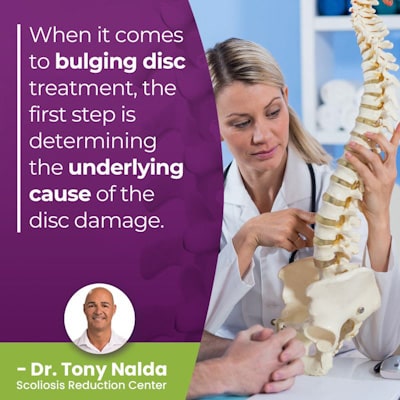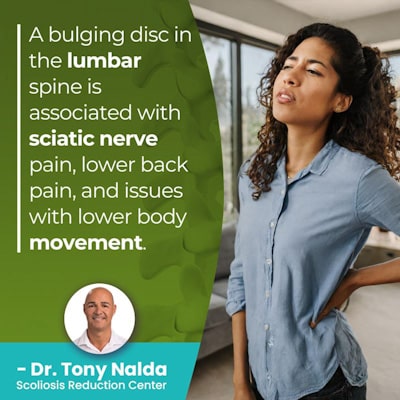Bulging Disc Symptoms: Diagnosis, And Effective Treatment

If a bulging disc is left untreated, it can turn into disc herniation; any change in disc health/shape can affect the disc's surroundings, particularly when a bulging disc is taking up more space inside the spine than it used to. A bulging disc can cause spinal canal compression, affecting the spinal cord within.
The spine's intervertebral discs are key to its overall health. A bulging disc develops as its inner nucleus pushes against its outer annulus, causing the disc to bulge outwards into its surroundings. A bulging disc can be painful, and treatment works towards improving disc health.
As the health of the spine is affected by the health of its discs, let's explore disc structure and function.
Table of Contents
Disc Structure
The spine consists of vertebrae (bones) stacked on top of one another, and adjacent vertebrae are separated by an intervertebral disc.
The spine consists of three main sections, and each section has a characteristic curvature type, and the spine's natural and healthy curves make it stronger, more flexible, and better able to absorb/distribute mechanical stress incurred during activity.
If the spine's natural curves are in place, its vertebrae are aligned as they should be, and the spine is balanced and stable; there are a number of spinal conditions/issues that involve a loss of its healthy curves.
The intervertebral discs consist of two main structures: an inner nucleus and an outer annulus.
The inner nucleus is soft and gel-like, and the outer annulus is a tough and durable outer layer.
The nucleus consists of water, collagen fibers, and proteoglycans, and the outer annulus consists of collagen and proteins.
If you picture a marshmallow held between two cookies, the marshmallow is the disc, and the two cookies are adjacent vertebral bodies; as you picture the marshmallow changing shape and losing height, consider how it would impact the connected cookies, and this is how a changing disc can alter the position of attached vertebral bodies.
Disc Function
 The discs are elastic to allow for spinal flexibility, and they also provide cushioning so that vertebrae don't rub against one another causing friction and spinal degeneration.
The discs are elastic to allow for spinal flexibility, and they also provide cushioning so that vertebrae don't rub against one another causing friction and spinal degeneration.
The discs also act as the spine's shock absorbers so stress from movement and impact can be evenly distributed throughout the entire spine, and as adjacent vertebrae attach to the disc in between, the discs also give the spine structure.
If a disc changes shape, it can affect the positioning of adjacent vertebrae, and this can change the structure of the spine, its curves, and disrupt its biomechanics.
The discs are the largest structures inside the body without their own vascular supply, meaning no direct path into the discs through which blood containing oxygen and nutrients needed are readily accessible, and through which waste can be eliminated.
Without their own vascular supply, discs are vulnerable to degeneration; in fact, the spine's intervertebral discs are generally the first spinal structures to experience degenerative changes, and degenerative disc disease is a contributing factor in the development of a number of spinal conditions/issues.
When we're born, the discs are made of 80-percent water, but as we age, that fluid level decreases, and disc desiccation develops when a disc has experienced excessive fluid loss, commonly changing shape, losing height, as a result, and affecting its surroundings.
What is a Bulging Disc?
When a disc's inner nucleus pushes out against its outer annulus, causing the disc to bulge outwards into its surroundings, this is known as a bulging disc, and when a disc's inner nucleus pushes against its outer annulus causing a tear, through which disc material leaks is known as disc herniation.
The spinal cord that runs through the spinal canal contains 31 pairs of spinal nerves, and depending on the location of the bulging disc, its symptoms will be shaped by the degree of nerve involvement.
If a disc is bulging in the lumbar spine, for example, it can expose nearby nerves to uneven pressure, and as the sciatic nerve starts in the lumbar spine, a bulging disc can compress the sciatic nerve, causing sciatic nerve pain felt anywhere along the extensive pathway of the nerve.
So the location of the affected disc is important when it comes to experienced symptoms; in most spinal conditions/issues, the area of the body located the closest to the affected area is going to feel the majority of its direct effects.
Bulging Disc Symptoms
 While a bulging disc can develop in any of the spine's main sections - the cervical spine (neck), the thoracic spine (middle/upper back), and the lumbar spine (lower back) - the most common location is in the lumbar spine.
While a bulging disc can develop in any of the spine's main sections - the cervical spine (neck), the thoracic spine (middle/upper back), and the lumbar spine (lower back) - the most common location is in the lumbar spine.
The lumbar spine is particularly vulnerable to a number of spinal conditions/issues because of the unique roles of the lower back's vertebrae; they have to support the weight of the entire trunk, the spinal sections above, and feel the effects of bending, twisting, and lifting motions.
A bulging disc in the lumbar spine is associated with sciatic nerve pain, lower back pain, and issues with lower body movement.
A disc that's bulging in the cervical spine is associated with neck pain, shoulder pain, tension headaches, and can affect the neck's range of motion as the cervical spine has to support the weight of the head, neck, and facilitates the neck's range of motion.
A bulging disc can be asymptomatic, or it can cause one or more of the following symptoms:
- Back pain
- Neck pain
- Shooting pain
- Weakness, numbness, or tingling sensations
- Muscle spasms and muscle weakness
- Changes to gait, balance, and/or coordination
- Bowel dysfunction
- Bladder dysfunction
- Sciatic nerve pain
When it comes to bulging disc treatment, the first step is determining the underlying cause of the disc damage.
Bulging Disc Treatment
Here at the Scoliosis Reduction Center, treatment plans are always crafted around a condition's underlying cause; this is the difference between treating a condition's symptoms, or their underlying cause, the condition itself.
Treatment plans for a bulging disc are crafted around its underlying cause, location within the spine, and experienced symptoms, and comprehensive assessment can involve orthopedic and neurological testing to check reflex, muscle strength, and nerve sensation; an X-ray helps to see what's happening in and around the spine and if there are areas of joint immobility contributing to the bulging disc symptoms.
The most-common cause of a bulging disc is disc degeneration caused by general age-related spinal degeneration, and while disc degeneration is difficult, if not impossible, to reverse, disc health and function can be improved over time.
Lifestyle guidance is important when disc degeneration is caused by lifestyle factors such as not maintaining a healthy weight, low activity levels, chronic poor posture, excessive consumption of alcohol and/or smoking, and/or repeatedly lifting heavy objects incorrectly.
A conservative chiropractic-centered treatment approach combines chiropractic care, a variety of therapies including physical therapy and hot/cold therapy for pain relief, and rehabilitation.
If a disc is bulging because of uneven pressure caused by a misaligned spine, chiropractic care can work towards realigning the spine to relieve pressure on its discs so a disc's inner nucleus can reclaim its central position inside the disc, and the disc can reclaim its central position between adjacent vertebrae.
Physical therapy and exercise can help increase the spine's surrounding muscle strength and support; a well-supported spine is stable and means less pressure on its individual structures, and increasing circulation around an affected disc means increased blood flow which can help with disc restoration by making nutrients more readily available through a process similar to osmosis.
Hot/cold therapy can help with short-term pain symptoms, as can anti-inflammatory medications, but for long-term symptom management, proactive treatment is recommended.
Conclusion
A bulging disk occurs when a disk's inner nucleus pushes outwards against its outer annulus, causing the entire disc to bulge outwards, encroaching on space used by other spinal structures and nerve roots.
When it comes to bulging disk symptoms, while some can abate on their own when minor, if symptoms persist, treatment shaped around their underlying cause is necessary.
Common causes of a bulging disk include general disc degeneration, disc desiccation, degenerative disc disease, and the cumulative effect of certain lifestyle factors.
The goal of bulging disc treatment is to preserve disc function and prevent further damage and disc herniation.
Herniated disk symptoms can include arm and/or leg pain, numbness or tingling sensations, muscle weakness, and nerve damage.
While pain medication is available for short-term pain relief, for any long-term sustainable pain relief, proactive treatment that addresses the underlying cause of the disc damage is required, and here at the Center, that involves comprehensive assessment and treatment plans customized around the condition's underlying cause and experienced symptoms.
Dr. Tony Nalda
DOCTOR OF CHIROPRACTIC
After receiving an undergraduate degree in psychology and his Doctorate of Chiropractic from Life University, Dr. Nalda settled in Celebration, Florida and proceeded to build one of Central Florida’s most successful chiropractic clinics.
His experience with patients suffering from scoliosis, and the confusion and frustration they faced, led him to seek a specialty in scoliosis care. In 2006 he completed his Intensive Care Certification from CLEAR Institute, a leading scoliosis educational and certification center.
About Dr. Tony Nalda
 Ready to explore scoliosis treatment? Contact Us Now
Ready to explore scoliosis treatment? Contact Us Now





